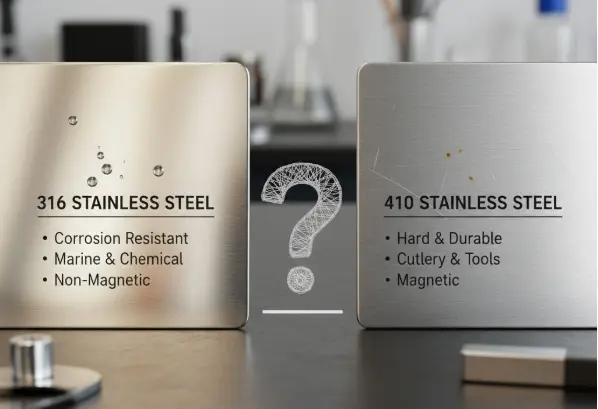Making a decision between the various grades of stainless steel is a baffling experience, in no time, when it comes to comparing 316 vs 410 stainless steel. Both of them sound powerful and solid, but their practical performance can be completely different depending on the way and location of usage.
Which one then should you select to use at your next project? It would be good to simplify it.
What Is 316 Stainless Steel?
316 stainless steel is often called marine-grade stainless steel — and for good reason. It’s built to survive harsh environments, especially where salt, moisture, or chemicals are involved.
Here’s what’s inside it:
- Chromium (16–18%) is helpful for corrosion resistance.
- Nickel (10–14%), which provides strength and flexibility.
- Molybdenum (2–3%) for extra protection against chloride and salt damage.
That extra molybdenum is what makes 316 stand out from most other stainless steels.
- You can use it to ship parts and marine hardware.
- It includes chemical processing plants.
- It has food and beverage equipment.
- Various surgical and medical tools.
It’s smooth, shiny, easy to clean, and great for welding — all reasons why it’s one of the most popular stainless steels worldwide.
What Is 410 Stainless Steel?
410 stainless steel, on the other hand, belongs to the martensitic family. That means it’s tougher, harder, and better at handling physical stress — but it sacrifices some corrosion resistance in return.
Composition-wise, it includes:
- Chromium (11.5–13.5%)
- Carbon (0.15–0.65%)
- Small amounts of manganese and silicon
This mix makes it perfect for uses where strength and wear resistance matter more than corrosion protection — like:
- Knives and blades
- Pump parts and valves
- Kitchen tools and utensils
- Fasteners and screws
However, unlike 316, stainless steel 410 vs 316 doesn’t perform well in humid, salty, or chemical environments.
Key Differences Between 316 and 410 Stainless Steel
Both steels are part of the stainless family, but their internal makeup changes how they behave in the real world.
| Feature | 316 Stainless Steel | 410 Stainless Steel |
|---|---|---|
| Type | Austenitic | Martensitic |
| Corrosion Resistance | Excellent, even in saltwater | Moderate; can rust in harsh environments |
| Strength | High but flexible | Very high and hard |
| Magnetism | Non-magnetic | Magnetic |
| Main Elements | Chromium, Nickel, Molybdenum | Chromium, Carbon |
| Heat Resistance | Up to 870°C | Up to 600°C |
| Weldability | Easy to weld | Needs pre-heating |
| Cost | Higher | More affordable |
| Common Uses | Marine, chemical, food, medical | Tools, valves, pumps, fasteners |
So, if your project faces moisture, chemicals, or seawater — 316 wins hands down. But if you need something tough, rigid, and affordable, 410 is your guy.
Corrosion Resistance: 316 Is the Winner
This is where 316 truly shines. Thanks to its molybdenum content, it resists pitting and crevice corrosion — the kind of damage that salt and acids cause over time.
That’s why 410 stainless steel vs 316 often comes down to one simple question:
“Will it face water, humidity, or chemicals?”
If yes → choose 316.
If no → save money with 410.
Strength and Hardness: 410 Takes the Lead

410 stainless steel can be heat-treated for extra hardness — making it ideal for wear-heavy tools and mechanical parts.
While 316 offers excellent flexibility and toughness, it can’t match the hardness level of 410. This makes 410 better for:
- Cutlery and blades
- Pump shafts
- Gears and mechanical components
Weldability and Forming
316 stainless steel is much easier to weld and shape. It doesn’t need special pre-heating or post-treatment, which saves both time and effort during fabrication.
410, being martensitic, requires careful heating to avoid cracking during welding. So, if your project needs lots of cutting, bending, or joining, 316 is the smarter pick.
Cost Comparison: 410 Is More Budget-Friendly
Let’s be real — price always matters.
316 is more expensive because of its higher nickel and molybdenum content. But that cost pays off when you need long-term resistance in tough environments.
If your project doesn’t face corrosion, you can save significantly with 410 stainless steel.
Typical Applications
316 Stainless Steel Applications:
- It includes Marine equipment and ship parts
- You can use Chemical storage tanks
- It also has Medical devices and surgical instruments
- Food and beverage machinery are included.
- Pharmaceutical equipment is a part of it.
410 Stainless Steel Applications:
- It has many kitchen tools and Cutlery.
- It provides Pump components and valves.
- Fasteners and screws are a valuable part of it.
- This application contains Industrial machine parts
- You can use Shafts, gears, and bearings in it.
Quick Recap: 316 vs 410 Stainless Steel
| Category | Best Choice |
|---|---|
| Corrosion Resistance | 316 |
| Strength & Hardness | 410 |
| Marine & Chemical Use | 316 |
| Tools & Mechanical Use | 410 |
| Budget Option | 410 |
| Easy Fabrication | 316 |
Which Should You Choose?
There’s no “one-size-fits-all” answer.
- If your environment is wet, salty, or chemical-heavy, 316 stainless steel is the clear winner.
- If you need hardness, wear resistance, and a lower price, go with 410.
Think of it this way:
316 = Long-term protection and premium performance.
410 = Tough, affordable, and perfect for heavy-duty use.
Related Grades (Know These Too)
You might also come across other grades like 403 stainless steel or 18-8 stainless steel vs 304 ss.
These are similar alloys but vary slightly in nickel, carbon, and chromium levels. Understanding these can help you fine-tune your material choice for your project.
FAQs
1. Which is better, 410 or 316 stainless steel?
Neither is universally better — it depends on where you’ll use it. 316 performs best in corrosive or marine settings, while 410 is stronger and better for mechanical wear.
2. What is 410 stainless steel?
410 is a martensitic stainless steel known for its hardness and strength. It’s commonly used in tools, blades, valves, and fasteners.
3. Is 18-8 stainless steel the same as 304?
Yes, 18-8 stainless steel generally refers to 304 stainless steel — both contain around 18% chromium and 8% nickel.
4. Is 416 stainless steel magnetic?
Yes, 416 (like 410) is magnetic because it’s part of the martensitic stainless steel family.
5. Which stainless steel is best for kitchen use?
For long-term kitchen or food-related use, 316 stainless steel is best due to its superior corrosion resistance and easy cleaning.
Conclusion
If you compare the 316 vs 410 stainless steel, both are useful for your environment and performance needs.
- Go with 316, which offers excellent corrosion resistance, durability, and hygiene.
- Choose 410 for strength, hardness, and cost efficiency.
Both are strong, reliable alloys — but choosing the right one for the job ensures your investment lasts for years.

